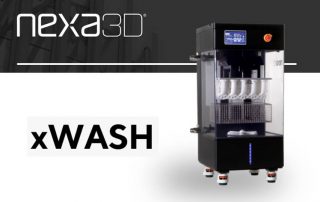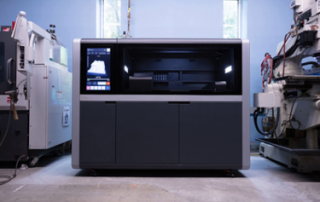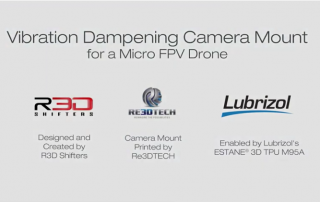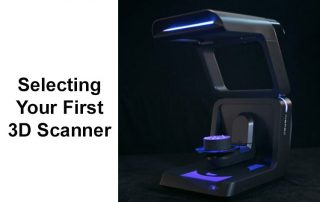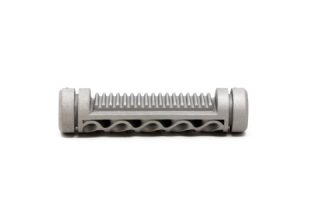xWASH Smart Affordable and Sustainable Washer from Nexa3D
Nexa3D, the maker of ultra-fast polymer 3D printers, recently announced the immediate commercial availability of xWASH, a new automated washer that works exclusively with its sustainable xCLEAN washing detergent to help manufacturers streamline, optimize, and scale their 3D printing and post-processing operations. The new xWash is a fully automated, smart cleaning washer that is designed to readily accept a full build plate from the company’s flagship NXE400 3D printer at volumes of up to 16 liters per print job. Customers using xWASH can experience significant post-processing cost reductions of as much as 75% compared with other post processing units and realize orders of magnitude throughput gains by producing consistent high-quality parts. “As demand for additively manufactured parts in volume production applications increases, the consistency of mechanical properties and finishing details is more important than ever, meaning there is greater need for automated, controlled, validated and sustainable post-processing solutions,” explained Kevin McAlea, COO at Nexa3D. “Our new xWASH matches the build volumes and process requirements of our ultrafast NXE400 3D printer, giving manufacturers repeatable and consistent control of their washing cycles. It also represents the final step in our end-to-end validated workflow, completing our suite of ultrafast photoplastic production system." Accessing an end-to-end post-processing [...]
Metrology Minute – Flatness
In continuing our series on GD&T callouts, today's Metrology Minute focuses on Flatness. Flatness is a very simple callout that focuses on just how flat a particular surface is without making reference to any specific datum. Very often, a Flatness callout can determine whether a job shop is able to face mill a surface to its finished dimension or if grinding and perhaps outside services are required to achieve the necessary Flatness. If a specific feature on a part needs to be uniformly flat within a given tolerance, without affecting or including any other dimensions or callouts on a drawing, Flatness is commonly used. A Min and Max tolerance are provided, which essentially callout two parallel planes as compared to the nominal (exact) flat surface. The resulting surface after machining must be flat and lie within these planes to therefore be within tolerance. The callout below references two parallel planes within .030 meaning none of the resultant, manufactured surfaces can have any points that measure outside of that provided tolerance. Using the manual, traditional measuring methods, Flatness is measured using a height gage or CMM, dragging a probe over the surface however with today’s software technology for inspection, very often color maps may [...]
Is Metal 3D Printing Ready for Primetime?
By Joseph Castine A reprint from https://www.fabbaloo.com/news/lessons-from-cimquests-2021-xpand3d-event-part-one With the rapid expansion of the additive manufacturing industry, metal printing technologies continue to emerge, but this raises the question “Is Metal Printing Ready for Primetime?” The discussion by Nate Higgins (President, FreeFORM Technology), Ric Fulop (Founder/CEO, Desktop Metal), Bob Hedrick (President, CAMufacturing Solutions), Kenneth Fortier (Product Owner – Visualization and Simulation, Mastercam), and Rob Hassold (CEO/Founder, Cimquest) came together to discuss. The metal segment is one of the fastest-growing of the additive manufacturing market, with some of the technology only recently becoming affordable. This is due largely in part to Desktop Metal, a company dedicated to making this growing technology more accessible for engineers, designers, and manufacturers. Desktop Metal went public at the end of 2020 with a valuation of $2.5 billion. Desktop Metal’s recent acquisitions include Adaptive 3D for elastomer and rubber materials and EnvisionTEC for photopolymer printers. Within this industry, there are several metal additive manufacturing technologies emerging, including Binder Jet. Binder Jet is a technology that Desktop Metal has implemented in their Shop and Production Systems, since the printers use laserjet printing heads which can be found in paper printers around the globe, the systems can produce parts up to 100 times [...]
Drone Customization With 3D Printing
a reprint from https://www.lubrizol.com/ Breakthrough TPU enables innovator to better serve hobbyists In the world of manufacturing, it’s often difficult to make the numbers work when serving a niche market. When your market is a niche of a niche, the challenge becomes even greater. Yet, R3D Shifters is doing just that, successfully catering to the hobbyist sector of the non-commercial drone market. “These aren’t the people who run out and buy a drone right off the shelf,” explains Netanel Bellaishe, company co-founder and lead designer. “These are the folks who want to essentially build their own drone.” To help them do that, R3D Shifters designs and manufactures chassis and parts customers can complete with their own motors, control boards and other largely standardized components. To serve this narrow market efficiently, R3D Shifters relies on MJF 3D printing on the 4200 and the capabilities of the latest TPU (thermoplastic polyurethane) technology. Business could not have taken off with injection molding It would be possible to make many of R3D Shifters’ products with injection-molded plastic, but with nowhere near the efficiency necessary to be viable. “Simply creating a mold might cost between $50K to $100K, which would require running thousands and thousands of parts to [...]
Selecting Your Company’s First 3D Scanner
by Harry Foxman - a reprint from https://www.fabbaloo.com/news/lessons-from-cimquests-2021-xpand3d-event-part-one What to look for in selecting a 3D Scanner Over the past three decades, scanning technology has advanced immensely. It is now a helpful tool to be used in reverse engineering, inspection, and 3D printing. With a large number of different types of scanners from a variety of manufacturers on the market today, it is important that a company selects the correct one. Before beginning the search for a scanner, companies should have predetermined criteria mapped out. In order to narrow down the vast field of scanners on the market, there are several different steps to consider guiding you in the right direction. The first step is to determine what sizes of parts you want to scan. Are the parts large or small, mechanical or organic? For example, scanning a part to be used in a machine would require a drastically different scanner than scanning a feature on a body. The application of what is scanned also needs to be considered. An item can be scanned for a variety of reasons including reverse engineering, metrology, 3D printing, web content, and virtual reality. Additional software processing costs are also something that needs to be considered as [...]
Desktop Metal Qualifies 4140 Low-Alloy Steel for High-Volume Additive Manufacturing
The First Company to Qualify 4140 via Metal Binder Jetting for the Mass Production of Strong Steel Parts That Withstand High Impacts, Temperatures and Mechanical Stresses Desktop Metal, a leader in mass production additive manufacturing (AM) solutions, today announced it has qualified the use of 4140 low-alloy steel for the Production SystemTM platform, which leverages patent-pending Single Pass JettingTM (SPJ) technology designed to achieve the fastest build speeds in the metal additive manufacturing industry. Desktop Metal is the first and only company to qualify 4140 low-alloy steel for use with metal binder jetting systems, enabling its use in mass production end-use part applications. Desktop Metal is the first and only company to qualify 4140 low-alloy steel for use with metal binder jetting systems, enabling its use in mass production end-use part applications. This linear pneumatic piston is used to convert air pressure into rotary motion through a rack and pinion with 4140 providing the toughness and wear resistance required for this application. (Photo: Business Wire) Considered one of the most versatile low-alloy steels, 4140 is characterized by its toughness, high tensile strength, and abrasion and impact resistance. It is a critical all-purpose and heat-treatable steel used extensively in a variety of [...]


